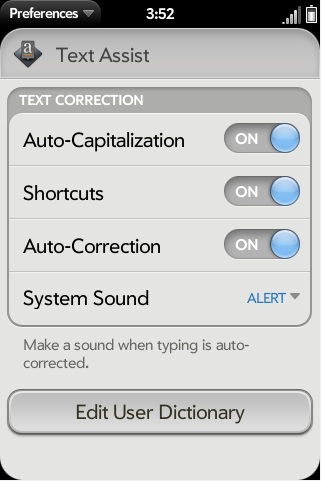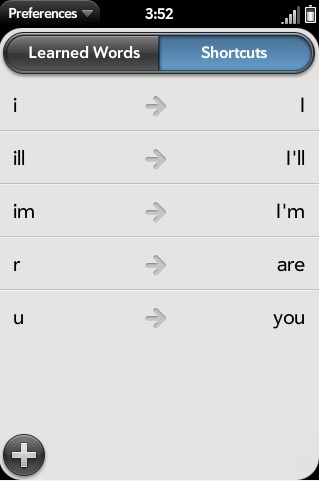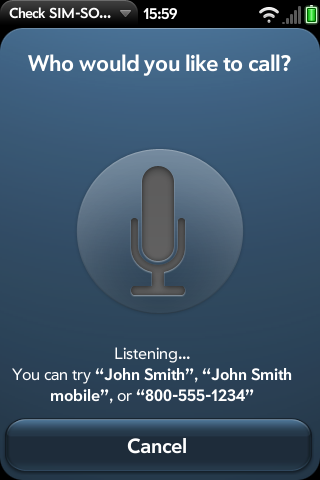webOS 2.0 Overview
by Mithun Chandrasekhar on February 3, 2011 6:05 PM ESTOther Updates
Overall, the UI has been polished up in webOS 2.0. While I cannot comment on the performance because of the non-final software I was running, the transition animations themselves appeared very smooth. HP has also updated certain HTML 5 features supported by webOS and rolled in the popular node.js Javascript framework runtime into webOS 2.0, thereby letting developers come up with their own background services in Javascript, in addition to the applications themselves. There are also a couple of other consumer-facing updates that are worth mentioning.
Although all webOS devices to date (all of two!) have had physical keyboards, spelling correction has been absent in webOS until now. Whether this is because we’ll be seeing keyboard-less webOS devices in the future or because HP thought it would be a good idea to include it anyway, we finally have a spell-check in webOS. Dubbed “Text Assist”, it performs the usual gamut of auto-corrections and lets you enter a list of user defined words.


Text Assist makes its (useful) debut on webOS 2.0
The one nice touch I most definitely appreciate here is the ability for the user to define word shortcuts. The user can now define mappings between shorthand words and how they’re supposed to be auto-corrected. “im” will become “I’m”, “were” will be set to “we’re” etc. where appropriate.
A sorely missing feature in webOS that HP has finally added is voice dial and command. By virtue of this, they have opened up developer access to the device mic. This will certainly bring in a flurry of VOIP apps, with Skype confirming that it will release a version of its app for the webOS platform (although it looks as though it will be restricted to Verizon-only devices, at least initially). This definitely fills a void in the webOS platform that has been open for far too long.



(Left)Voice dial, (Center) Favorites, (Right) dialer app now in blue
The final big update webOS 2.0 brings along with it is the inclusion of Flash 10.1 support. Yes, after multiple “It’s coming soon” promises, this iteration of webOS finally adds Flash support. Now you might be shocked to see this listed way down here, almost towards the end of the article, but there is a reason for this.
As I had mentioned earlier, we didn’t get a Pre 2 device for this article. I made use of the beta webOS 2.0 SDK and a “doctored” version of webOS 2.0 on my Pre Plus. Because of this, I could not get a true representation of the performance of the Flash implementation in webOS 2.0. This was because the SDK would be running on a full-fledged computer and the version of webOS 2.0 I had running on my Pre Plus was definitely not final.
That being said, I could see the all-important banners and short clips without much trouble. However, full-blown Flash videos were definitely choppy, with gesture controls (zoom, scroll etc.) not working. I will put this down to the beta-ness of the build and more importantly the fact that the Pre Plus only has an OMAP 3430 down-clocked to 500Mhz. Because a webOS 2.0 compatible build of Uberkernel is not around yet, I could not see if overclocking the CPU made it better in any way or form.










46 Comments
View All Comments
Noriaki - Thursday, February 3, 2011 - link
It's nice to have the flexibility of Flash I suppose, but I have little use for it in practice and I usually don't have it installed on my Nexus One. I mostly find it to be a waste of battery.On the nexus one it's a market place app I can install/remove as I like. Is there some way to control/disable Flash support in webOS2 ?
mythun.chandra - Thursday, February 3, 2011 - link
You can enable/disable Flash support in the browser. Also, even if Flash support is enabled, you can toggle whether or not to load Flash content automatically on a page.Noriaki - Thursday, February 3, 2011 - link
Oh toggle to load automatically, I like that!Thanks for the info. I'm pretty interested to see what comes of webOS2.
tekeffect - Thursday, February 3, 2011 - link
I got the pre the day it came out. I liked the OS then but the build quality of that phone was shit. I will never understand how they put that much effort into making a OS and put it on the shittiest plastic/hardware they could find. I'm with Android now with no intention of leaving. I wonder how many people would be willing to go to Web OS after so much time.JHBoricua - Thursday, February 3, 2011 - link
I would, in an instant. But, only as long as the applications are there. That's the only reason I have an Optimus LG now, I got tired of HP dragging their behind and the lack of usable applications on the Pre. The application ecosystem on Webos is pathetic at this time. I couldn't care if coming February 9 HP shows some awesome hardware, if they won't have the apps behind the platform it will be the Pre all over again.I like WebOS. IMHO it beats Android and IOS hands down in terms of usability and the user interface experience is absolutely great, but what is the point if the apps are not there?
DigitalFreak - Thursday, February 3, 2011 - link
Exactly. It's a catch 22 really. Without the apps, people won't buy the phone. Without people buying the phone, developers won't create apps.While WebOS 2.0 may be technically better than Android, iOS, etc., having only one or two phones just isn't going to cut it.
retrospooty - Sunday, February 6, 2011 - link
"I will never understand how they put that much effort into making a OS and put it on the shittiest plastic/hardware they could find"I worked for Palm for 5 years from 02 to 07. They are never able to fire on all pistons at the same time to get anything meaningful done... Alot of good people there, but the management on the hardware/engineering side is useless.
My favorite quote from a Palm employee? "I have never seen so many smart people that truly care and are trying hard, go into a meeting together and come up with such stupid solutions"
firechiefsta - Monday, February 7, 2011 - link
That's the most perfect comment I have ever read about Palm. You nailed it right on, 100%. Great work.I've loved palm since the Vx days, but these last few years have been painful, to say the least.
Sad.
DigitalFreak - Thursday, February 3, 2011 - link
"Build quality aside, the Pre/Pre Plus had the innards to, at the very least, keep up with the competition of its time and the OMAP 3630 in the Pre 2 is the very same found in the capable and well received Droid X."The Droid X will be a year old soon (if it's not already). HP should be releasing a Pre 2 with next gen hardware if they really want to capture any meaningful amount of market share. Being an also ran isn't going to work.
mythun.chandra - Thursday, February 3, 2011 - link
I get that the 3630 isn't exactly the "in" thing...quite far from it. But I honestly feel that the the pace at which mobile CPU's are jumping forward every couple of months in terms of performance, soon we will be reaching a plateau in terms of how much CPU power we really need in a 3.5-4" device. Look at the desktop/notebook sector...apart from the Atom's, when was the last time you really felt the CPU was slowing you down?IMHO, the hardware needs to complement and be able to support the software it's driving. Now whether this means using a slow, low-power CPU with a software stack that almost entirely depends on the GPU (a la Nokia N8), or have it balanced like in case of the Pre 2 and webOS 2.0. At the end of it, it is the experience of using the device that really counts, not whether the CPU underneath is running at 1 or 1.5Ghz.
That being said, the upcoming HP/Palm tablets should also whet your appetite fo raw CPU power :)